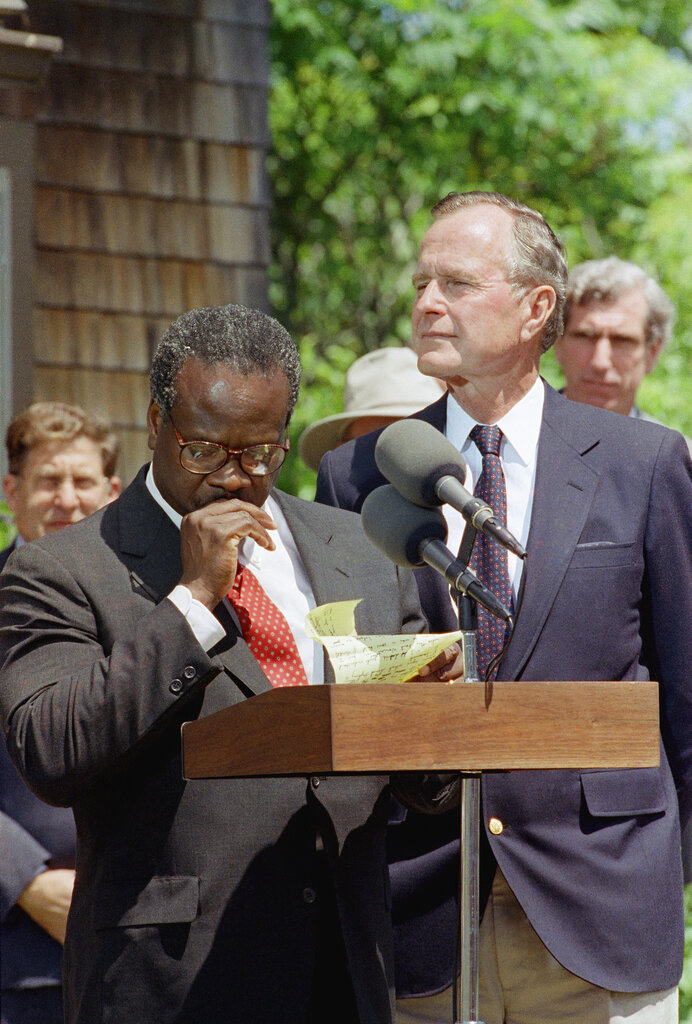Thirty-one years ago today, Clarence Thomas, then a federal appeals judge, thought he had dodged a bullet aimed directly at his quiet lifestyle.
At the time, he was a leading candidate to replace retiring liberal Justice Thurgood Marshall but felt he had been passed over by former President George H.W. Bush. And he was good with that.

Thomas had met with justice officials days earlier and thought they told him that if he wasn’t picked by Sunday, he wasn’t going to get the job.
“Saturday morning came. I wasn’t nominated, and I said, ‘Free at last,’” he told the authors of the new book, Created Equal: Clarence Thomas in His Own Words. “I had a new Corvette, and Virginia and I drove to Annapolis and celebrated not being nominated,” he told co-authors Mark Paoletta and Michael Pack.
Sunday, he went to work at the district federal courthouse, and an aide rushed in with news. “Kennebunkport is on the line,” the aide said in a reference to Bush’s summer home in Maine.
“It was the president telling me to come up on Monday to have lunch to discuss ‘this Supreme Court thing,’” Thomas told the authors whose book is a longer companion to their movie about Thomas released two years ago.
Thomas, now the senior judge on the court, still thought he was a long shot and that he was going to meet the president just to offer advice.
1/ After a superb game-changing Supreme Court term that ended yesterday, it’s worth noting that it all began 31 years ago today, when President Bush nominated Clarence Thomas to the Court. Watch Thomas’s beautiful speech that day. As he says, “Only in America.” pic.twitter.com/175pEUOZR2
— Mark Paoletta (@MarkPaoletta) July 1, 2022
But Ginni Thomas suggested he take a little speech with him just in case. “Earlier that morning, my wife said, ‘What if they nominate you? What are you going to say? You can’t say, ‘Oh, I thank my dog and I thank my mother and I thank my third-grade teacher.’ You got to have something to say,’” he said.
And she had some advice. “She made me sit down and write a short statement. I wrote it on a legal pad. And then she said, ‘I want you to say, Only in America.’ And so I added that. I put that in my pocket knowing I would never use it,” Thomas told Paoletta and Pack.
On July 1, 1991, he boarded a jet to Maine and saw top Bush legal officials and thought something was up. Later, walking around Bush’s oceanside estate, he ran into Barbara Bush, who let the cat out of the bag. “Congratulations,” she said.
Around 2 p.m. that day, to a small group of pool reporters including me, then with the Washington Times, Bush and Thomas approached a microphone in the backyard. Thomas rightly recalled that when he emerged from the home, reporters said, “Oh, Thomas.”
Many of the questions to the president that day were on Thomas’s race, with Bush brushing aside that he considered the Marshall seat a minority seat, though he was happy to pick a minority. “So much the better,” said Bush, who repeatedly said he picked the best person for the job.
I asked Thomas, “Judge, what do you say to critics who say that the only reason you’re being picked is because you are black?”
Thomas responded, “I think a lot worse things have been said. I disagree with that, but I’ll have to live with that.” Bush, to some laughter, asked me, “Are you referring to the press? How about that for an answer?” Thomas then said, “I also say I didn’t make the selection.”
In a video clip making the rounds in conservative circles today to celebrate the anniversary and first major decisions by the new conservative court that started forming in 1991, Thomas is shown reading from his notes, penned on yellow legal pad paper. “In my view, only in America could this have been possible,” he said.
Today, Paoletta, who helped Thomas get through the nasty nomination process, tweeted, “After a superb game-changing Supreme Court term that ended yesterday, it’s worth noting that it all began 31 years ago today, when President Bush nominated Clarence Thomas to the Court.”

